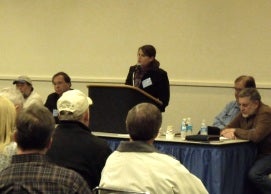
Kate Culzoni speaks to watermen at the East Coast Commercial Fishermen's & Aquaculture Trade Exposition in Ocean City, Maryland.
Over a half a foot of snow couldn’t keep watermen away from the East Coast Commercial Fishermen’s & Aquaculture Trade Exposition in Ocean City, Maryland this past weekend. The state’s biggest fishing association, the Maryland Watermen’s Association, organized a weekend full of events and seminars highlighting issues on watermen’s minds. Environmental Defense Fund had the honor of participating in this event by organizing a seminar called “Co-Managing the Future of Your Fishery – Experiences and Lessons from Fishermen across the Country.”
To bring some context to the subject, we brought in fishermen from around the nation including the President and Treasurer of the Gulf of Mexico Reef Fish Shareholders’ Alliance, David Krebs and Buddy Guindon. We also tapped the expertise of Alaska halibut fisherman, Mark Lundsten and New England fisherman and catch shares expert, Dick Allen. These fishermen led a panel discussion on their experiences and lessons going from traditional fisheries management systems to catch shares management.
Gulf fishermen and Maryland watermen talk at the East Coast Commercial Fishermen's & Aquaculture Trade Exposition in Ocean City, Maryland.
The President of the Maryland Watermen’s Association, Larry Simns, opened the session requesting something from the 50 or so watermen in the audience. “Whether you are for or against catch shares, we all need to keep an open mind and see how at least parts of this system can help the future of our fisheries,” Simns stated.
Maryland watermen asked many questions and raised concerns about catch shares but repeatedly said they were maintaining an open mind about the solutions that catch shares can offer to fisheries.










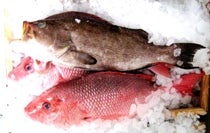 On Jan. 1, 18 Gulf of Mexico commercially-caught grouper and tilefish species were added to the region’s individual fishing quota (IFQ) program, a type of catch share. This newly expanded program is a big conservation victory. Now, 19 valuable Gulf fisheries are being managed under a tool proven to rebuild struggling fish stocks.
On Jan. 1, 18 Gulf of Mexico commercially-caught grouper and tilefish species were added to the region’s individual fishing quota (IFQ) program, a type of catch share. This newly expanded program is a big conservation victory. Now, 19 valuable Gulf fisheries are being managed under a tool proven to rebuild struggling fish stocks.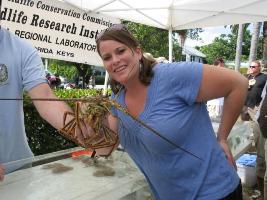 A few weeks ago, I attended the
A few weeks ago, I attended the 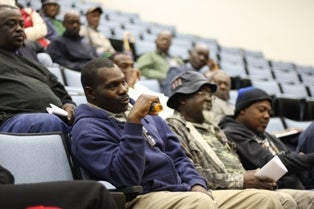 The Oceans program has developed robust relationships with an array of people across the U.S. including fishermen, scientists, academics, and political leaders; however, it‘s not every day that it works closely with royalty. Over the past several weeks, the Oceans program has partnered with
The Oceans program has developed robust relationships with an array of people across the U.S. including fishermen, scientists, academics, and political leaders; however, it‘s not every day that it works closely with royalty. Over the past several weeks, the Oceans program has partnered with 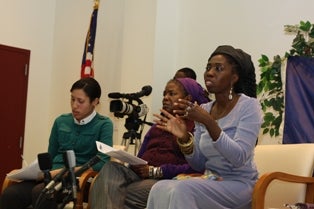 Because the continuity of this way of life is pertinent for Queen Quet and her people who have fished for generations, she expressed a keen interest in collaborating with EDF to better understand the challenges facing African-Americans for what has been perceived as a changing rate of participation in subsistence and commercial fisheries. To best document the concerns of this community, EDF and the Gullah/Geechee Sea Island Coalition cosponsored a listening session in Beaufort, South Carolina on January 21st. The event was a great achievement and brought together local and state officials and approximately 30 fishermen. For a group that generally has not been present at public forums in the past, this turnout signified the importance of the subject.
Because the continuity of this way of life is pertinent for Queen Quet and her people who have fished for generations, she expressed a keen interest in collaborating with EDF to better understand the challenges facing African-Americans for what has been perceived as a changing rate of participation in subsistence and commercial fisheries. To best document the concerns of this community, EDF and the Gullah/Geechee Sea Island Coalition cosponsored a listening session in Beaufort, South Carolina on January 21st. The event was a great achievement and brought together local and state officials and approximately 30 fishermen. For a group that generally has not been present at public forums in the past, this turnout signified the importance of the subject.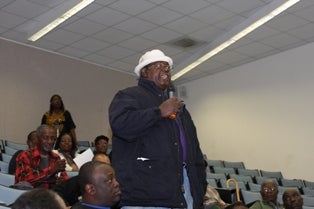 According to Queen Quet, seafood is one of the major sources of employment for the Gullah/Geechee. During the meeting, the fishermen openly shared their concerns about the fishing industry, drawing comments from nearly everyone in the auditorium throughout the night.
According to Queen Quet, seafood is one of the major sources of employment for the Gullah/Geechee. During the meeting, the fishermen openly shared their concerns about the fishing industry, drawing comments from nearly everyone in the auditorium throughout the night. The recent U.N. Climate Change conference in Copenhagen highlighted the range of challenges associated with fighting climate change, from cutting energy use to financing clean technology in developing countries. Why the global sense of urgency and focus? Because the impacts of climate change are already being felt. Most of our discussions center on the dangers of sea level rise, which is already inundating low-lying islands and valuable wetlands; on changes in precipitation and air temperature, which will affect everything from agriculture to asthma; and on the shift in seasons and habitat that will make life difficult for trees, butterflies, and the other wildlife we are familiar with.
The recent U.N. Climate Change conference in Copenhagen highlighted the range of challenges associated with fighting climate change, from cutting energy use to financing clean technology in developing countries. Why the global sense of urgency and focus? Because the impacts of climate change are already being felt. Most of our discussions center on the dangers of sea level rise, which is already inundating low-lying islands and valuable wetlands; on changes in precipitation and air temperature, which will affect everything from agriculture to asthma; and on the shift in seasons and habitat that will make life difficult for trees, butterflies, and the other wildlife we are familiar with.